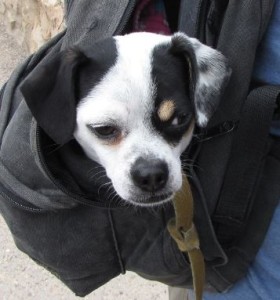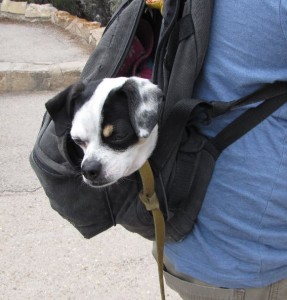Hiking with your dog is a wonderful past time. Recently, I was hiking on the north rim of the Grand Canyon when I met Frankie. He was ‘hiking’ out to Bright Angel Point with his family. Frankie does not like crates because his prior family kept him locked up for extended periods of time. But, he loves backpack rides! When the hike is over, he naps in the car on the way home. In fact, his family states he has ‘CARcolepsy’, falling asleep soon after the engine starts.
Here are my tips for hiking with your dog:
1) Water – Bring plenty of fresh water for you and your pet. Resting fluid requirements for dogs are approximately 1 ml. per pound per hour. That means a 10 pound pooch requires 10 mls. every hour just to meet their metabolic requirements at rest. If the dog is running around and panting, another 10 to 20 mls. may be needed to avoid dehydration. Letting the dog lap out of the palm of the hand wastes a lot of water. To avoid waste and having to carry even more water, I recommend a recycled margarine container. Though some people like them, I find the fabric, flexible bowls too cumbersome to use.
2) Food – Unless the dog “hikes” like Frankie, hiking burns a lot of calories. Bring along biscuits or dog kibble to provide energy. Feed every 2 hours of active hiking. Hypoglycermia (low blood sugar) is common in active dogs. Watch for weakness, incoordination and lethargy. Some dogs act drunk when their blood sugar drops. If this occurs, feed them immediately. If they can’t eat, place honey in their mouths and then feed ASAP.
3) Sunscreen – Dog skin, especially pink areas, is susceptible to sunburn just like human skin. Hike before 10am or after 4pm when the intensity of the sun has lessened. Also, apply a pet-safe sunscreen like Epi-pet every 2 hours. Avoid sunscreen with zinc as ingestion may cause anemia.
4) Flexi lead – I love retractable leashes for hiking because they give the dog freedom to explore while still keeping them under control. I also recommend keeping dogs close to prevent wildlife attacks. Please take extra precautions with small dogs ( < 20 lbs) that may be carried away by hawks, owls and eagles.
5) Make sure the dog is current on vaccinations, heartworm monthly treatment, flea and tick preventative. Although hiking is fun, it also exposes dogs to potential health problems that can be avoided with preventative care. Flea and tick control are vital to prevent disease like the plague in the desert southwest and Lyme disease in the northern US states.
6) First aid kit – a) Bandages, tape and roll gauze b) Tweezers c) Antiseptic solution for treating cuts d) Eye wash e) Diphenhydramine (Bendadryl) for allergic reactions f) Packets of honey for treating hypoglycemia
7) Booties – When hiking in rough terrain, pad lacerations are always a problem. If your dog will tolerate them, booties are a great option for protecting pads. Some even come with cooling packs or heating packs that can be placed inside the bootie depending upon the weather.
Happy Hiking!

